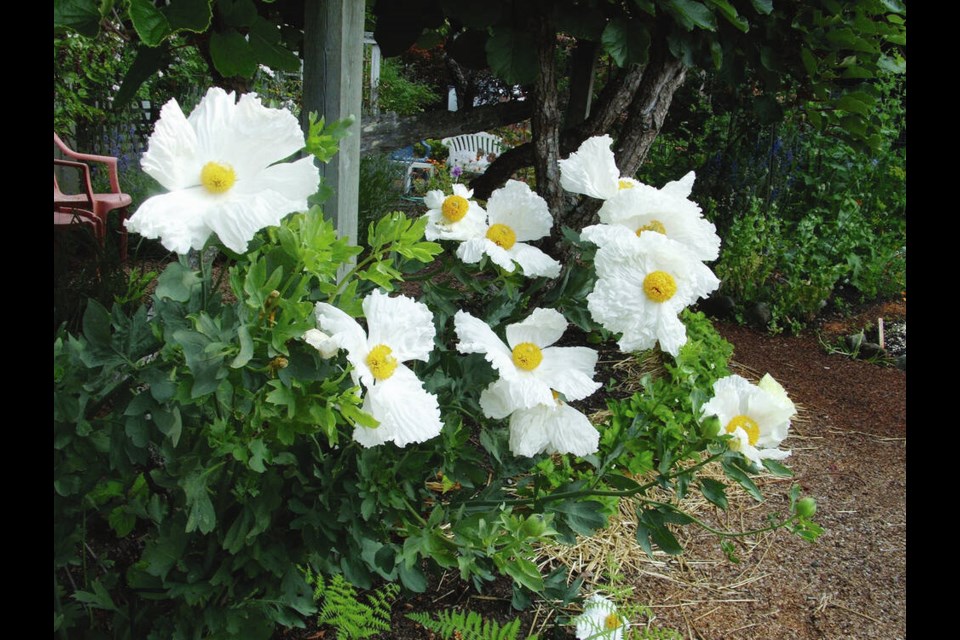I can see it from an upstairs bedroom window. A big, imposing patch of white at the far end of the back garden, 70 metres away — an early summer flower display that arrived on its own, probably from a few stray seeds.
Every year, the mass of chest-high shasta daisies expands and becomes more impressive, with big blooms on stems like steel rods.
The shasta daisies (Leucanthemum superbum) have arranged themselves in a long, broad arc around a tall red huckleberry shrub, one of the many native plants that were growing on the property when I arrived and that I’ve been carefu l to retain in the landscape.
The location of this large flower display is at the end of a path leading to a row of five compost enclosures, three of which are currently occupied by rapidly expanding winter squash plants. One could call the area a vibrantly “happening” little corner of the garden.
The huckleberry and companion shasta daisies grow across a pathway from the food garden, in an area that is not watered. The only maintenance needed for the planting is cutting back in late winter and removing enough of the planting’s outer edge in the spring to leave free passage around it.
Such plants are of value beyond price, delivering a reliable, annual show of bright beauty in return for little care.
A different shasta daisy planting, one I grew from seed the year the variety, Snow Lady, earned an All-America Selections award, grows in another rather inhospitable corner, in the front garden. Snow Lady is a dwarf shasta daisy that has persisted in dryish ground that is occupied by roots from neighbouring forest trees, to form a curved edging for equally enduring Epimedium (bishop’s hat, barrenwort) plantings.
Floral velvet. As the showy shasta daisies began attracting the attention of visiting friends, nearby Matilija poppy plants were drawing much interest as well. The giant poppies occupy several small patches of ground on both sides of the same pathway that ends with the tall daisies. I can’t remember how long ago I acquired the original plant, but since then it has spread, not intrusively, to several adjacent areas, to set up patches of the shrub-like perennials.
Matilija poppy (Romney coulteri, California tree poppy) does have a reputation for “travelling.” I recall a note from a gardener describing how her plant sent a root underneath the garage, to emerge at the base of the wall opposite the parent plant.
My original plant has moved about in more modest fashion, only across a narrow path and into an adjacent woodland clearing. A stray shoot proved not hard to pull up and keep from establishing under the kiwi vines
This year’s show of flowers has been the best yet. It’s almost impossible to pass by them without reaching out and feeling the soft, velvety texture of the deeply crinkled white petals that surround bright yellow centres. For this colour combination, the blooms are sometimes called “fried egg flower.”
I cut my Romneya plants back early in the spring, making cuts right above nodes of potential growth pointing in the direction I want the stems to take. From the time the plants develop they are attractive. The leaves are lovely in waxy-textured grey-green, divided into lance-shaped lobes.
My neighbour over the back fence has been admiring the big poppy flowers and has expressed an interest in having them in her garden. I have my eye on a few young shoots developing alongside one of my Romneya plantings. In the next not-too-hot bit of weather, I’ll dig a few, pot them, keep them just modestly watered in a place out of hot sun, and hand them over once I’m certain they are living.
GARDEN EVENTS
Historic location reopened. Point Ellice House, 2616 Pleasant St., Victoria, has re-opened under new stewardship. Nearly two acres of garden and the visitor centre, with its historical exhibits, are open Thursday through Sunday from 10 a.m. to 4 p.m. More information at pointellicehouse.com.
Plant sales. The Friends of Government House Gardens Society open the plant nursery, across from the tea room at Government House, 1401 Rockland Ave., Victoria, from Tuesday through Thursday, 10 a.m. to 2 p.m. Most of the plants are sold for $8, payable by debit or credit cards only.



